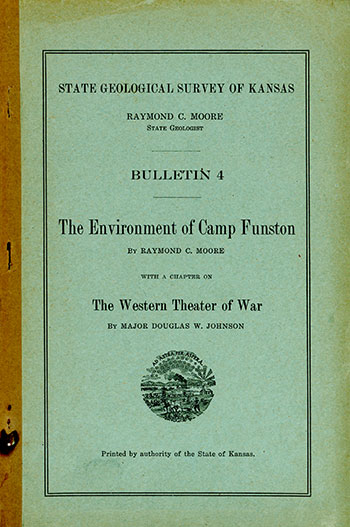The Environment of Camp Funston
by Raymond C. Moore
with a chapter on
The Western Theater of War
by Major Douglas W. Johnson

Originally published in 1918 as Kansas Geological Survey Bulletin 4. This is, in general, the original text as published. The information has not been updated. An Acrobat PDF version (29 MB) is also available, with Plate 1 available separately (58 MB).
Letter of Transmittal
Dr. Frank Strong, Chancellor of the University of Kansas, ex officio Director of the State Geological Survey:
SIR—I submit herewith a report on the environment of Camp Funston, the purpose of which is to describe and interpret the topography and geology of a portion of our state in which many thousands of the young men from Kansas and neighboring states are being trained intensively for service abroad. The intimate relation between military operations and the country in which they are laid is very well recognized. This report is intended to call specific attention to features of the terrain about Camp Funston which are of important military significance, and to compare them with conditions on the Western Front. It is believed that the comparisons made will be of considerable practical value and interest to the men in training at the camp.
The report is one of several which have been undertaken at various army camps throughout the United States, at the suggestion of the Geology and Paleontology Committee of the National Research Council, after conferences with prominent military men.
This report will constitute Bulletin 4 of the Reports of the State Geological Survey of Kansas.
Respectfully submitted.
Raymond C. Moore,
State Geologist.
Foreword
The armies engaged in the present Great War know that the physical features of the country in which they fight affect almost their every activity, Each campaign demonstrates how large a role is played by the ground over which the armies move and fight. Military strategy is based on geography and topography as fundamentally as upon the fighting ability of armies. Mountains and rivers are barriers to the movement of armies; plains invite them forward, steep slopes hinder or make impossible movements of artillery, cavalry, tanks, or infantry; gentle slopes are open to them. Defensive lines are placed where the advance of the enemy Will he most difficult-along hills, steep cliffs, swamps, large rivers, covers of forest; Offensive movements are directed toward country easy to traverse. Details of topography determine the landing places of aeroplanes, and control to a greater or less degree the effectiveness of gas warfare; character of soils and underlying rocks determine whether trenches may be constructed quickly and maintained effectively. The study of these features broadly and in detail is absolutely essential to the proper direction of troops in the field and to a clear understanding of the movements of armies. Maps showing all the physical features of areas in which movement of troops is likely to occur are sought by the war departments of all countries, those of France and other European countries being almost astonishingly minute in detail. For Pershing's advance at St. Mihiel more than 100,000 maps of the area concerned were used.
In recognition of the vital relations which exist between an army and the country it occupies or traverses, the following brief description of the country about Camp Funston has been prepared for the soldiers in training there. Only the salient facts necessary to a proper appreciation of the topography and other features of military importance in the area are presented, points of academic or special technical interest being purposely omitted. Comparison is made with conditions in northern France in order that notice of the physical features about Camp Funston may be related as closely as possible to the surroundings which the soldier will find in actual service on the West Front. While this description is primarily intended to aid in training men for most effective service in the present conflict, it is hoped that it may be of permanent interest and value to an established military organization like that at Fort Riley. Through the kindness of Major Douglas W. Johnson and the publishers of his "Topography and Strategy in the War," Henry Holt & Co., a most valuable and readable account of the chief physical features in the western theater of war, and the effect they have had on the campaigns of the war, taken from this work, is presented in Chapter I. It is very well worth the attention of every officer and soldier.
Kansas Geological Survey, Geology
Placed on web Feb. 12, 2018; originally published 1918.
Comments to webadmin@kgs.ku.edu
The URL for this page is http://www.kgs.ku.edu/Publications/Bulletins/4/index.html